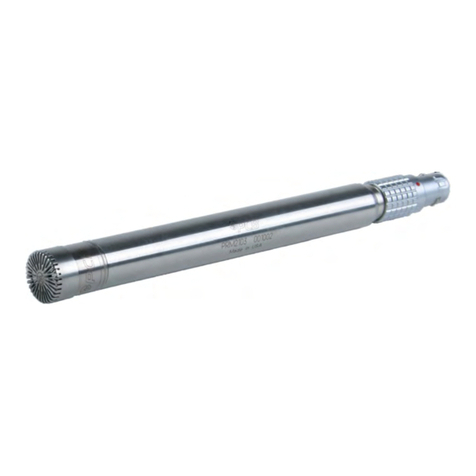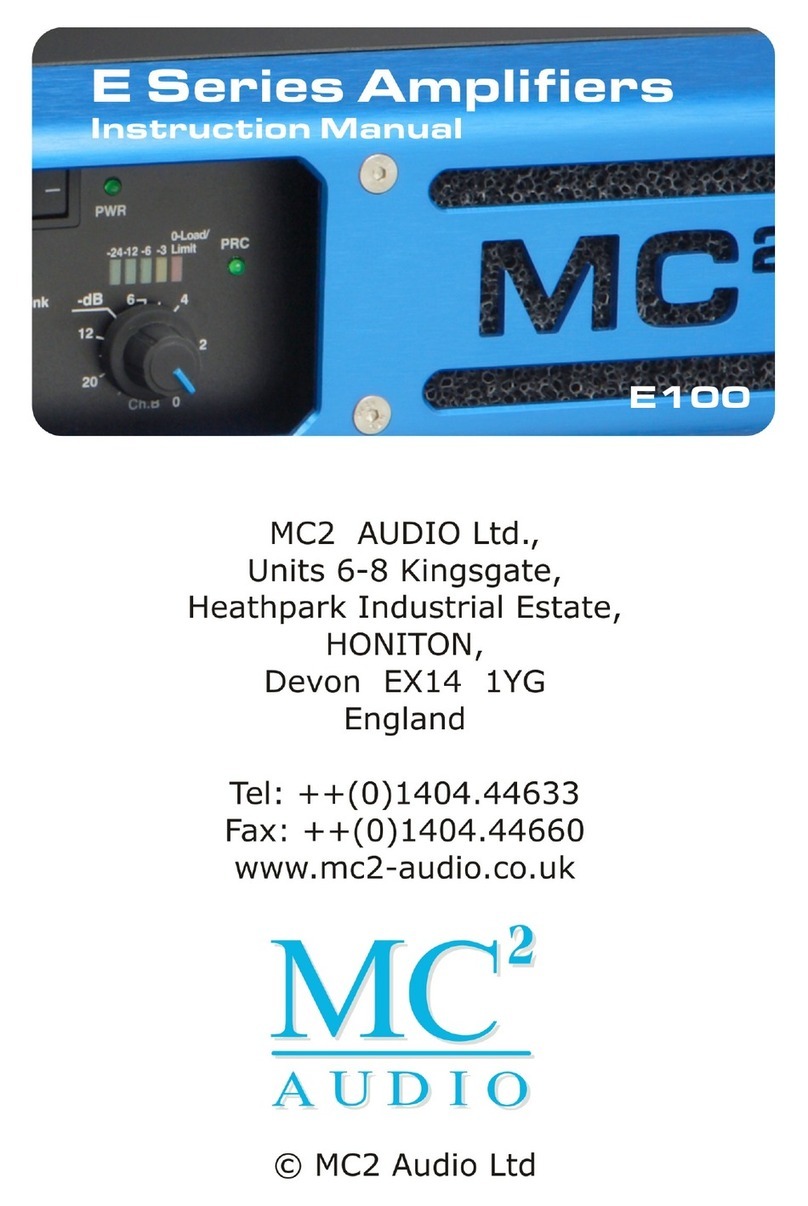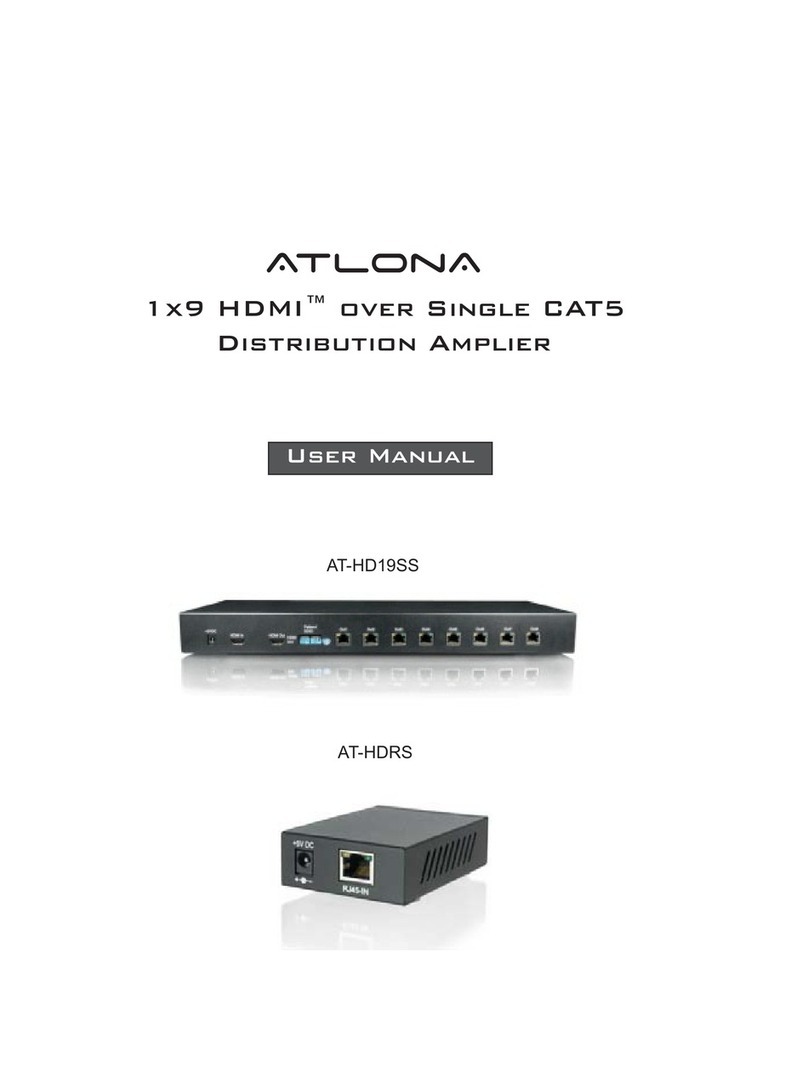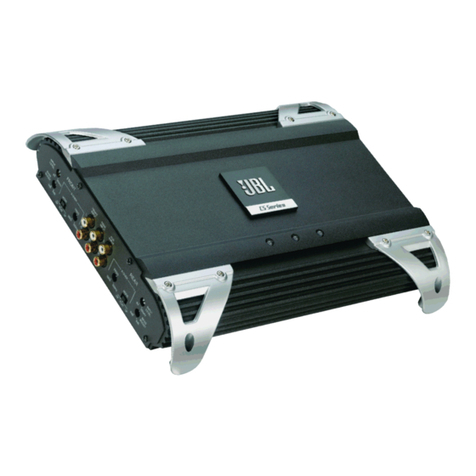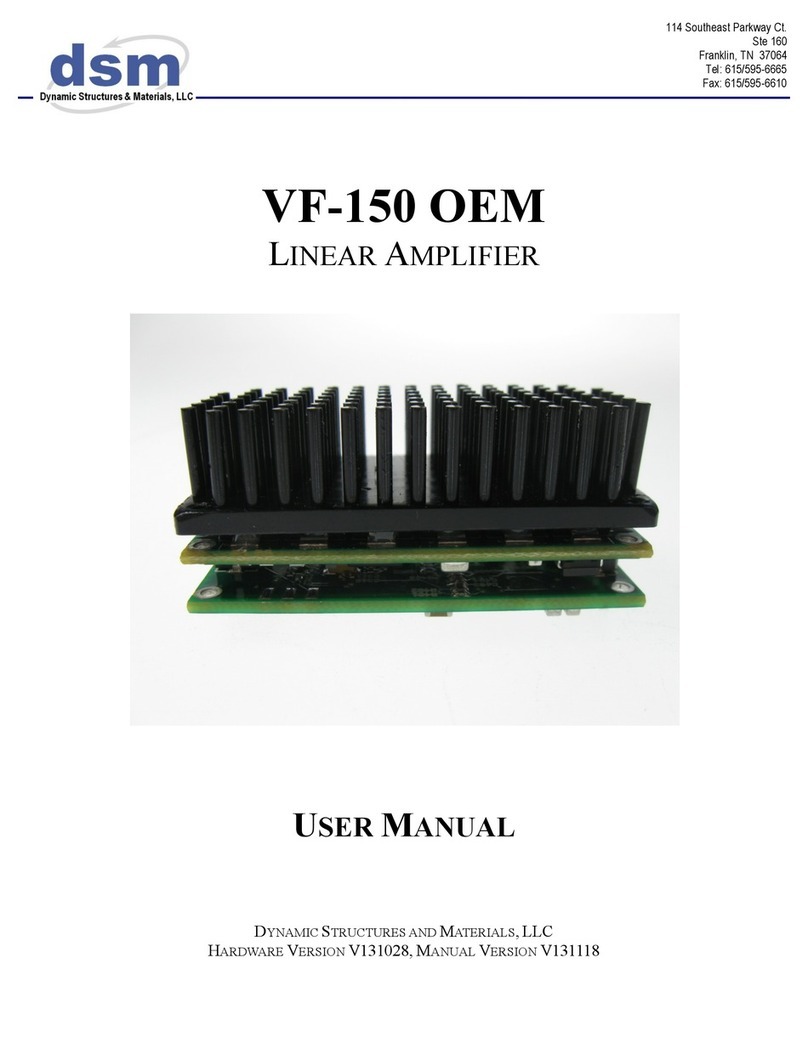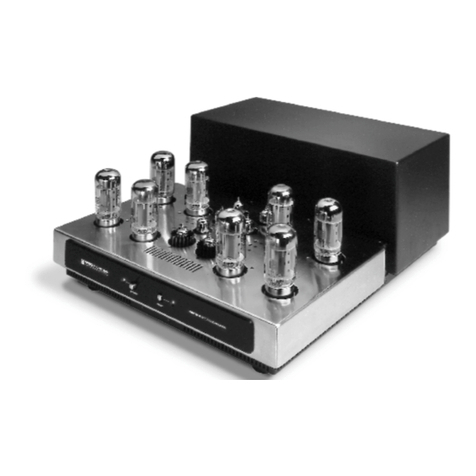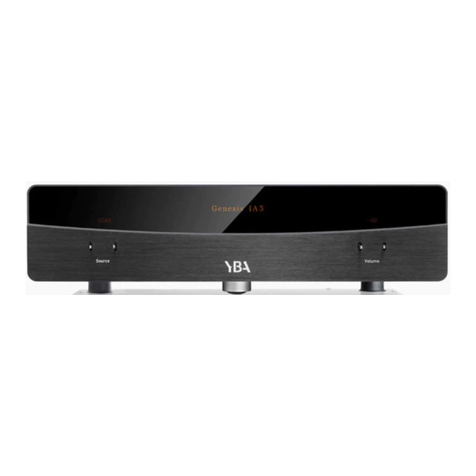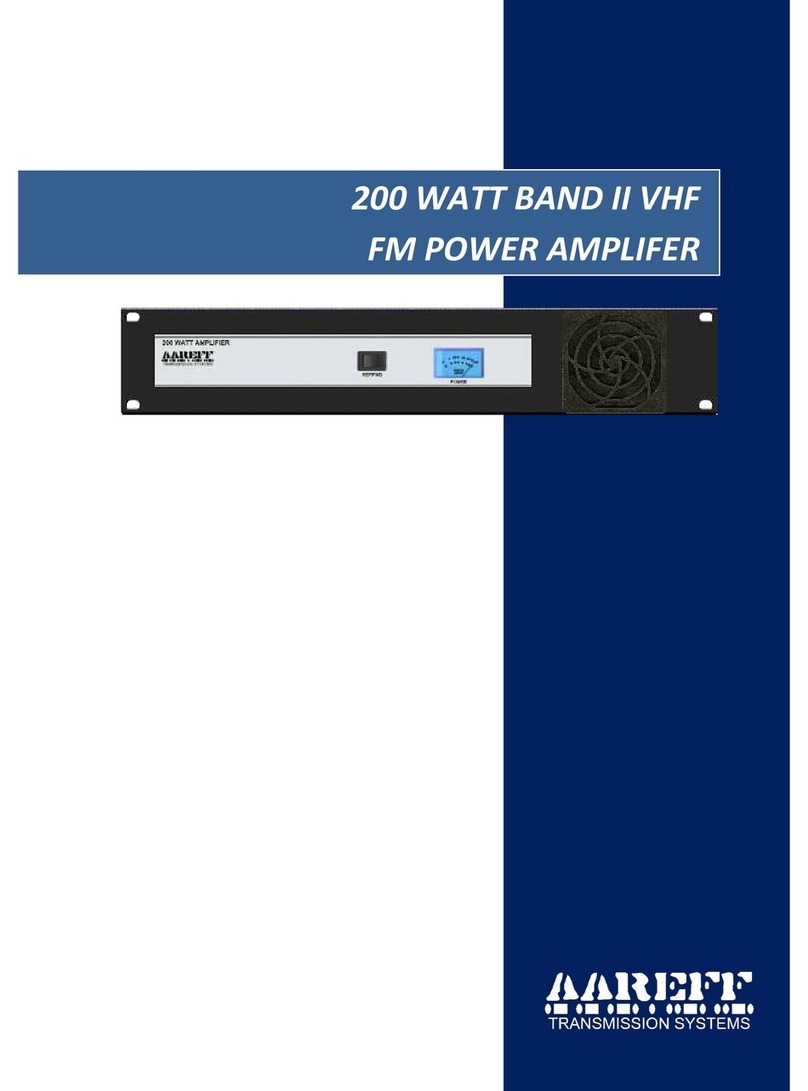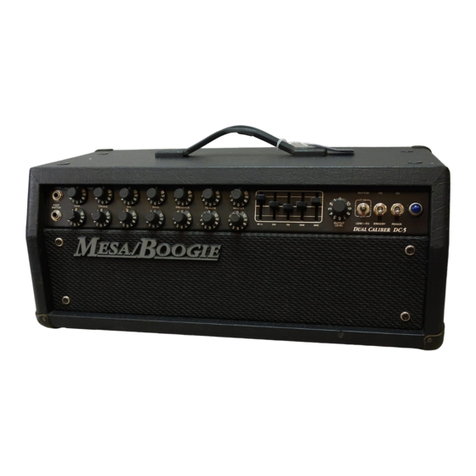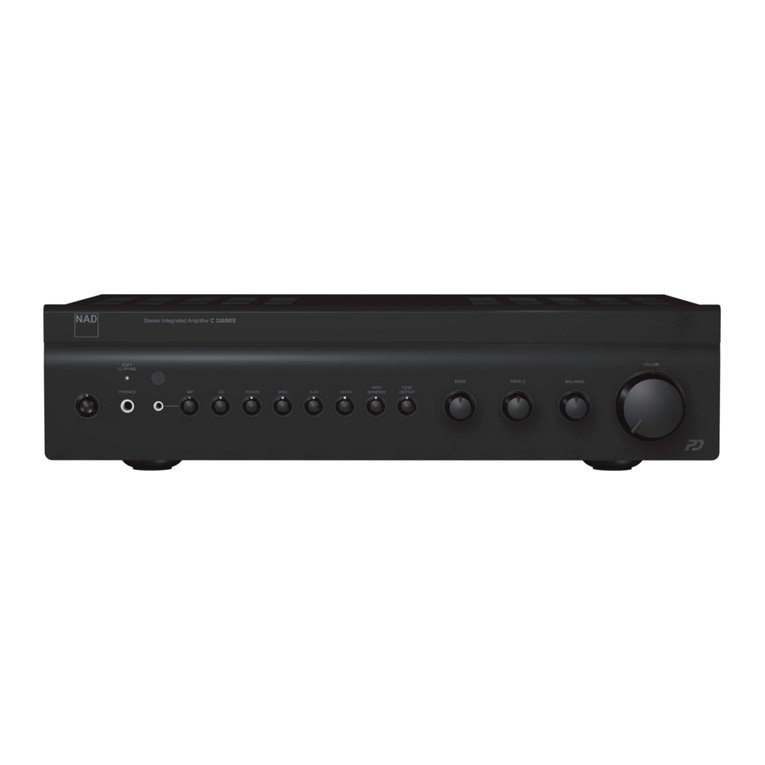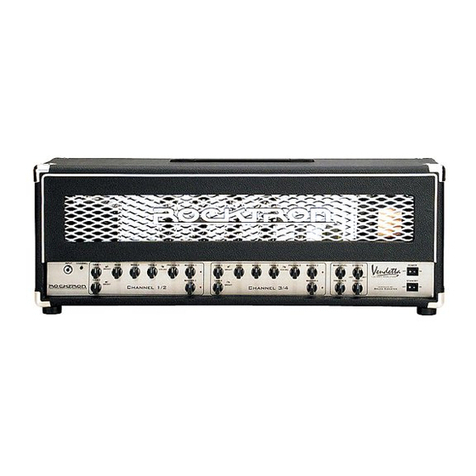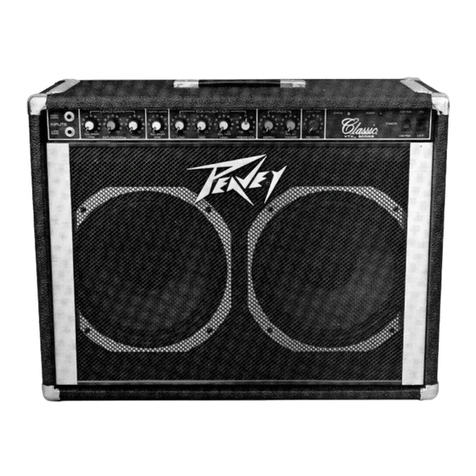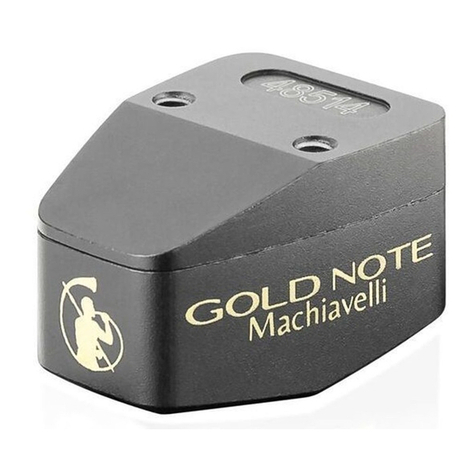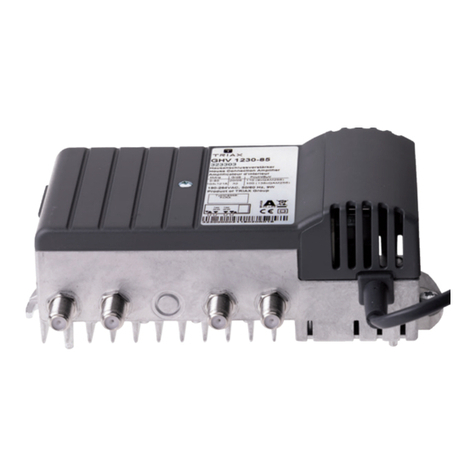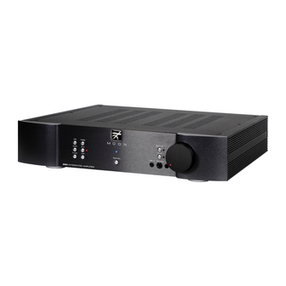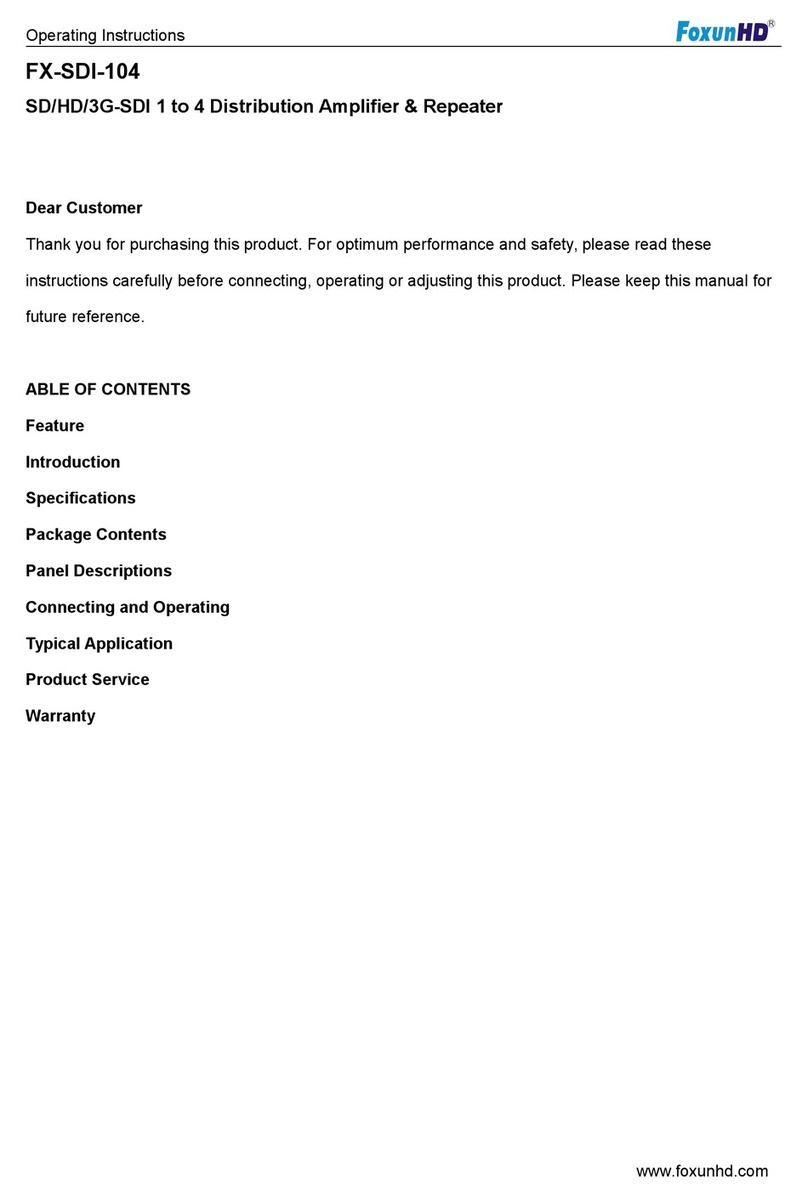New Stage Accompany ES 40 User manual

EFFICIENCY SERIES ES 40
High Efficiency Power Amplifier
User Manual
stage accompany
R
ES 40 USER MANUAL

Published by:
New Stage Accompany B.V.
Training & Documentation
Anodeweg 4
1627 LJ Hoorn, The Netherlands
Copyright © 2000 by New Stage Accompany B.V.
All rights reserved. No part of this manual may be reproduced or transmitted in any form or by
any means, electronically or mechanical, without written permission from New Stage Accom-
pany B.V. , except for the inclusion of brief quotations in a review.
First printing, August 2000
Printed in The Netherlands
This manual is intended to provide information about the Stage Accompany ES 40. Every effort
has been made to make this manual complete and as accurate as possible. However no
warranty of suitability, purpose, or fitness is implied. The information is provided on an “as-is”
basis. New Stage Accompany B.V. shall have neither liability nor responsibility to any person
or entity with respect to any loss or damages in connection with or arising from the information
contained in this manual.
New Stage Accompany B.V. reserves the right to alter specifications without prior notice.
stage accompany
R
ES 40 USER MANUAL

stage accompany
R
ES 40 USER MANUAL
Table of Contents
Quick Introduction to the ES 40
Introduction
Connections
Operation
Recommendations
Technical Specifications
Warranty
Overview

Table Of Contents
1 Quick Introduction to the ES 40 ................................. 1-1
2 Introduction ................................................. 2-1
3 Connection of the ES 40 ....................................... 3-1
3.1 Mains Power Connection ................................... 3-1
3.2 Audio Connections ........................................ 3-4
3.3 Loudspeaker Connections .................................. 3-5
3.4 Installing the EFN ......................................... 3-11
4 Operation ................................................... 4-1
4.1 Input Attenuators ......................................... 4-1
4.2 Bridge Mode Switch ....................................... 4-1
4.3 Ground Lift Switch ........................................ 4-2
4.4 Indicators ............................................... 4-2
5 Recommendations for Optimum Use............................. 5-1
6 Technical Specifications....................................... 6-1
7 Warranty .................................................... 7-1
8 Overview.................................................... 8-1
TABLE OF CONTENTS
stage accompany
R
ES 40 USER MANUAL

1 Quick Introduction to the ES 40
Thank you for choosing a Stage Accompany Power Amplifier. Making this choice has guaran-
teed you many years of troublefree amplification.
If you have to start using the ES 40 straight away and do not have time to read the complete
manual, make sure that you at least read the following:
•Ensure that you have a reliable, well earthed power source. The required current for
the ES 40 can be found in the table in paragraph 3.1.
•Connect the ES 40 to your signal sources via the <INPUT> connectors. Connect this
amplifier to other units via the <LINK> outputs using short signal leads. Connect your
single signal source to the channel 1 input and your speaker system to the channel 1
output if you use the ES 40 in bridge mode.
•Never make connections to the amplifier or to any preceding equipment with the ampli-
fier switched on!
Important
When combining ES 40s with a Stage Accompany Blue Box system,you must take into account
thatthelow-frequency loudspeakeroftheBlueBoxhasanexcursionoppositetothatofanormal
speaker-amplifier combination. The Blue Boxes in combination with the ES 40s have to be
switched to inverted phase, or cross cables for ES 40s or Blue Boxes have to be used!
•Switch the ES 40 on using the <POWER ON/OFF> switch.
If you want to use the ES 40 in bridge mode, set the <MODE> switch at the back of the amplifier
in the <BRDG MODE> position.
•Select the desired input sensitivity by means of the <INPUT ATTENUATORS>. In
bridge mode, only use the channel 1 attenuator.
•Any hum that may be present may be solved with the <GROUND LIFT> switch.
The ES 40 is now ready for use.
QUICK INTRODUCTION
stage accompany
R
ES 40 USER MANUAL
1-1

2 Introduction
The Stage Accompany ES 40 is a dual channel, high efficiency power amplifier and comprises
the following components:
•Balanced input stages.
•Individual power supplies for both channels.
•Two high efficient amplifiers which deliver each 1000 Wrms into 8Ω, 1470 Wrms into
4Ωand 1810 Wrms into 2Ωor 1240 W peak into 8 Ω, 2000 W peak into 4 Ω, and
2850 W peak into 2 Ω
.
•Advanced protection circuits.
The audio inputs and link outputs are connected internally without electronics. This is done to
prevent any loss of sound quality. With an input impedance of 22 kΩ, it is possible to connect
a maximum of 30 ES 40s to a 600 Ωsource like the SA 1310 graphic equaliser. If more than
30 units need to be connected to a single source, a separate signal driver must be used.
The ES 40 is protected against the connection of speaker impedances less than 2 Ωor even
short circuiting of the output. In these cases the output current is limited but the amplifier keeps
working.
The ES 40 has a number of features, including:
•High efficiency class G operation.
•Active Clip Eliminator (ACE)
•Variable speed DC fan.
•Dynamic Damping Control (DDC).
•Front accessible Extended Function Network (EFN)
•Soft start to reduce power on inrush current.
•Temperature, DC, HF and short circuit protection.
INTRODUCTION
stage accompany
R
ES 40 USER MANUAL
2-1

Class G operation
The power supply of the ES 40 amplifier produces 2 different supply levels. Each channel
actually consists of two power amplifiers. One produces the output signal, the other one selects
the power supply voltage. This way, the ES 40 uses the low level supply at low output power
and the high level supply at high output power which reduces internal dissipation significantly.
ACE
The Active Clip Eliminator circuit (ACE) in the ES 40 constantly monitors both power amplifiers
for continued clipping. When clipping is detected the input level of the related channel is
inaudibly reduced tothe safest maximumlevel. Thisfeature prevents harmonics damaging your
sound quality and high frequency drivers and also protects the amplifier from running hot.
DC Fan
The built in DC fan has a continuous variable speed. Its control circuit monitors the temperature
of the output devices and the temperature of the power supplies. The speed of the fan is
calculated out of this information. This system ensures that the fan always runs at optimum
speed and thus produces less noise.
DDC
Dynamic Damping Control (DDC) is a special way of measuring the cone movement of a
loudspeaker. The voltage induced in the voice coil is sensed and fed back to the amplifier’s
feedbackcircuit.Hence,a virtuallyinfinitedampingisachieved,whichresultsinanexceptionally
tight sound reproduction.
EFN
Through the Extended Function Network (EFN), with plug-in modules, extra functions can be
added to the amplifier, like cross-over, high- low- or band-pass filtering, equalisation and
loudspeaker protection. Special protection boards are available for all Stage Accompany
loudspeaker systems.
Soft Start
The soft start circuit is active when the ES 40 is turned on. The mains inrush current, which
normally is in excess of 100 A is limited to a safe value. Also the second power supply is turned
on with a two second delay after the first power supply. However, take care not to switch on too
many amplifiers at the same time, or you risk that the main fuses of your distribution may trip.
Temperature, DC, HF, and Short Circuit Protection
The amplifier and the loudspeaker outputs are protected against all possible damages.
INTRODUCTION
stage accompany
R
ES 40 USER MANUAL
2-2

3 Connections
Only three connections need to be made: mains power, audio input signals, and loudspeaker
leads. Do not make any connections to the amplifier or to any preceding equipment with the
amplifier switched on!
3.1 Mains Power Connection
The ES 40 is internally selectable for 110-120/220-240V mains voltage. The exact voltages are
stated at the rear of the amplifier. Switching between mains voltages has to be done by an
authorised Stage Accompany service centre. Connecting to the wrong voltage is dangerous
and may damage the amplifier. Always ensure that you use a correctly grounded power supply.
If more than one ES 40 is to be used, it is advisable to connect each one separately to the
nearest mains supply in stead of connecting several ES 40s using an adapter block (see figure
3-1).
Mains
Supply
Mains
Supply
ES 40
ES 40
ES 40
ES 40
ES 40
ES 40
OK
Figure 3-1 ES 40 connections to the mains supply.
CONNECTIONS
stage accompany
R
ES 40 USER MANUAL

This will prevent unnecessary power loss in the mains cables. If circumstances do not allow
this, it is advisable to connect the adapter block directly to the power supply using a short cable
and then connect the individual ES 40’s to it using longer leads. Although this method is not
ideal, it does limit power loss as much as possible.
Ultimately, it is possible to place the adapter block near the ES 40s, but if a great deal of power
is required from the units, the final current provided is far from optimum: loss of current leads
to unrecoverable loss of output power and therefore sound pressure.
Warning :
Always disconnect theES 40 fromthe mainspower supplybefore operating onthefuse holders!
Replace a blown fuse only with a new one of the same type and value!
Current Table
Below, the current consumption of the ES 40 is tabulated for two selectable mains voltages.
The power consumption shown appliesto 1/8 ofmaximumoutput power pinknoisein2 Ω,which
is representative for typical music program with occasional clipping. If your speaker system has
an impedance of 4 or 8 Ω, you may multiply the currents by 0.5 or 0.25.
The mains voltage may NOT deviate more than -20 % to +10 % of the nominal value. The
proportional mains voltage cable loss may not exceed 10 %. The following formula may be used
to calculate the maximum mains cable length in meters for 220-240 V models:
No. ES 40s Mains Voltage (V)
110-120 220-240
Current Consumption (A)
12412
24824
37236
49648
5 120 60
6 144 72
7 168 84
8 192 96
9 216 108
Table 3-1 Current consumption as a function of the mains voltage at 1/8 of maximum
output power with pink noise in 2 Ω.
CONNECTIONS
stage accompany
R
ES 40 USER MANUAL
3-2

The two input variables are:
N - number of ES 40s supplied through the cable
G - cable gauge in square millimeters
For 110-120 V models the following formula applies:
This means that the cable length is proportional to the cable gauge, while it is inversely
proportional to the number of ES 40s supplied through the cable.
On this and the next page, per mains voltage a table is shown with the maximum mains cable
lengthinmeters,giventhe cablegaugeinsquaremillimetersand thenumberofES40ssupplied
through the cable.
Maximum Length (ML) =
G
*7.5
N
Maximum Length (ML) =
G
*30
N
110-120 V Cable Gauge (mm2)
1.5 2.5 4.0 6.0 10.0 16.0
No.
of
ES 40s
11119304575120
2 6 915233860
3 4 610152540
4 3 5 8 11 19 30
524691524
623581320
723461117
81245915
91235813
101235812
Table 3-2 Maximum cable length as a function of the cable gauge and the number of
ES 40s supplied through the cable.
CONNECTIONS
stage accompany
R
ES 40 USER MANUAL
3-3

3.2 Audio Connections
The XLR connectors (audio in and audio link) of the ES 40 are wired as follows:
Pin 1 = ground
Pin 2 = normal phase (signal+ or “hot”)
Pin 3 = inverted phase (signal- or “cold”)
It is not advisable to disconnect the ground pin at either side of the signal cable. Hum caused
by ground loops can practically always be solved with the use of the ground lift switch at the
back of the amplifier.
Always use high quality XLR connectors and shielded signal cables. Using the signal link
connectors, up to 30 ES 40s can be linked without a problem. If more than 30 ES 40s need to
be interconnected, a separate signal driver should be used.
Theinputstagesareelectronicallybalanced.Tomakeoptimumuseofthebalancedinputstages
even in unbalanced situations, use balanced signal cables and connect pin 3 to pin 1 at the
output of the preceding apparatus. If this is not possible, connect pin 3 to pin 1 at the input of
the ES 40.
NEUTRIK
+
+
12
3
220-240 V Cable Gauge (mm2)
1.5 2.5 4.0 6.0 10.0 16.0
No.
of
ES 40s
1 45 75 120 180 300 480
223386090150240
315254060100160
41119304575120
5 9 15 24 36 60 96
6 8 13 20 30 50 80
7 6 11 17 26 43 69
8 6 915233860
9 5 813203353
10 5 8 12 18 30 48
Table 3-3 Maximum cable length as a function of the cable gauge and the number of
ES 40s supplied through the cable.
CONNECTIONS
stage accompany
R
ES 40 USER MANUAL
3-4

3.3 Loudspeaker Connections
Due to theDDC feature, the ES 40 has4 output terminalsper channelinstead of 2.The speakon
connector is wired as follows:
Pin 1+ = “hot” or Signal+
Pin 1- = “cold” or Signal-
Pin 2+ = “DDC hot” or DDC+
Pin 2- = “DDC cold” or DDC-
For optimum performance, the amplifier to loudspeaker connections should be made as shown
in figure 3-2.
The signal+ and DDC+ (Dynamic Damping Control) terminals are linked together at the
loudspeaker +terminal. The signal-and DDC- terminalsare linked atthe loudspeaker -terminal.
A maximum dampingis obtained withthese connections. If your speaker systemis not prepared
for a four terminal connection, link the DDC and the signal leads at the input of the enclosure
(see figure 3-3).
+
+
NEUTRIK
1-
2+
1+
2-
2+
2-
1-
1+
+
-
SPEAKON NL4FC
Figure 3-2 ES 40 4-terminal loudspeaker connection.
2+
2-
1-
1+
+
-
SPEAKON NL4FC
Figure 3-3 ES 40 2-terminal loudspeaker connection
CONNECTIONS
stage accompany
R
ES 40 USER MANUAL
3-5

If you don’t want to use the DDC feature at all, the DDC and the signal leads should be linked
at the amplifier output in the speakon connector (see figure 3-4). The DDC terminals can also
be left unconnected but then the performance will be less.
Warning ! Never short-circuit the DDC terminals, and never connect the signal+ output terminal
to the DDC- terminal or vice versa (see figure 3-5). Since you are disabling the amplifier’s
feedback network, signal gain will be almost infinite. The smallest input signal will result in full
power output with the possibility of square waves damaging your loudspeakers!
Therefore, check your cables regularly. We also advice you to use special Stage Accompany
4-wire loudspeaker cable: 2 x 3.0 mm2and 2 x 0.75 mm2.
2+
2-
1-
1+
+
-
SPEAKON NL4FC
Figure 3-4 ES 40 loudspeaker connection without DDC.
2+
2-
1-
1+
+
-
SPEAKON NL4FC
Figure 3-5 Dangerous ES 40 output connection.
2+
2-
1-
1+
+
-
SPEAKON NL4FC
Figure 3-6 Dangerous ES 40 output connection
CONNECTIONS
stage accompany
R
ES 40 USER MANUAL
3-6

When more speakers are going to be connected to oneamplifier, split the output and DDC leads
as soon as possible behind the output terminals of the ES 40 (see figure 3-7 on this and figure
3-8 on the next page).
2+
2-
1-
1+
+
-
SPEAKON NL4FC
Figure 3-7 Try to avoid this way of connecting several enclosures to the
ES 40.
CONNECTIONS
stage accompany
R
ES 40 USER MANUAL
3-7

The amplifier can cope with any load of 2 Ωor higher. This means that you may connect a
maximum of two 4 Ω, four 8 Ω, or eight 16 Ωloudspeakers per channel in parallel. Linking the
loudspeakers from one enclosure to another has two major disadvantages:
1.The loudspeaker cable from the amplifier to the first enclosure conducts the current for all
enclosures, which means extra losses.
2.The DDC only works for the first enclosure.
Splitting the leads at the amplifier output terminals solves these problems (see figure 3-8). The
DDC system corrects the performance loss due to connectors, loudspeaker cables and so on.
However, it cannot prevent loss of power. So only use cables of minimal 2 x 1.5 mm2or more
for the loudspeaker leads and 2 x 0.75 mm2for the DDC leads.
For bridge mode operation, simply connect the speaker to the channel 1 output connector.
2+
2-
1-
1+
+
-
SPEAKON NL4FC
OK
Figure 3-8 Correct way of connecting several enclosures to the ES 40
2+
2-
1-
1+
+
-
SPEAKON NL4FC
Figure 3-9 ES 40 bridge mode to loudspeaker connections.
CONNECTIONS
stage accompany
R
ES 40 USER MANUAL
3-8

An indication of the proportional cable power loss (percentage of the amplifier’s total output
power) can be calculated using the following formula:
where the variables represent:
L - cable length in meters
G - cable gauge in square millimeters
R - DC resistance of the loudspeaker(s) in ohms
This formula is based on the DC resistance in stead of the complex impedance of the
loudspeaker(s). However, the approximation can be used to get a good impression of the
loudspeaker cable power loss. Per loudspeaker impedance a table is shown in tables 3-9 to
3-12 with the proportional power loss, given the loudspeaker cable gauge in square millimeters
and the cable length in meters.
Proportional Power Loss = 100
29.4 * G * R
L
1+
16 ΩCable Gauge (mm2)
1.5 2.5 3.0 4.0 6.0 10.0 16.0
Cable
Length
(m)
10 1.4 0.8 0.7 0.5 0.4 0.2 0.1
20 2.8 1.7 1.4 1.1 0.7 0.4 0.3
30 4.1 2.5 2.1 1.6 1.1 0.6 0.4
40 5.4 3.3 2.8 2.1 1.4 0.8 0.5
50 6.6 4.1 3.4 2.6 1.7 1.1 0.7
100 12.4 7.8 6.6 5.0 3.4 2.1 1.3
Table 3-4 Proportional power loss as a function of loudspeaker cable gauge and cable
length (%).
CONNECTIONS
stage accompany
R
ES 40 USER MANUAL
3-9

8ΩCable Gauge (mm2)
1.5 2.5 3.0 4.0 6.0 10.0 16.0
Cable
Length
(m)
10 2.8 1.7 1.4 1.1 0.7 0.4 0.3
20 5.4 3.3 2.8 2.1 1.4 0.8 0.5
30 7.8 4.9 4.1 3.1 2.1 1.3 0.8
40 10.2 6.4 5.4 4.1 2.8 1.7 1.1
50 12.4 7.8 6.6 5.0 3.4 2.1 1.3
100 22.1 14.5 12.4 9.6 6.6 4.1 2.6
Table 3-5 Proportional power loss as a function of loudspeaker cable gauge and cable
length (%).
4ΩCable Gauge (mm2)
1.5 2.5 3.0 4.0 6.0 10.0 16.0
Cable
Length
(m)
10 5.4 3.3 2.8 2.1 1.4 0.8 0.5
20 10.2 6.4 5.4 4.1 2.8 1.7 1.1
30 14.5 9.3 7.8 6.0 4.1 2.5 1.6
40 18.5 12.0 10.2 7.8 5.4 3.3 2.1
50 22.1 14.5 12.4 9.6 6.6 4.1 2.6
100 36.2 25.4 22.1 17.5 12.4 7.8 5.0
Table 3-6 Proportional power loss as a function of loudspeaker cable gauge and cable
length (%).
2ΩCable Gauge (mm2)
1.5 2.5 3.0 4.0 6.0 10.0 16.0
Cable
Length
(m)
10 10.2 6.4 5.4 4.1 2.8 1.7 1.1
20 18.5 12.0 10.2 7.8 5.4 3.3 2.1
30 25.4 16.4 14.5 11.3 7.8 4.9 3.1
40 31.2 21.4 18.5 14.5 10.2 6.4 4.1
50 36.2 25.4 22.1 17.5 12.4 7.8 5.0
100 53.1 40.5 36.2 29.8 22.1 14.5 9.6
Table 3-7 Proportional power loss as a function of loudspeaker cable gauge and cable
length (%).
CONNECTIONS
stage accompany
R
ES 40 USER MANUAL
3-10

3.4 Installing the EFN
Because the ES 40features the front accessibleExtended Function Network, the amplifierdoes
not have to be opened, nor does it have to be removed from its rack to install the EFN circuits.
To (re)place the EFN board(s), switch off the amplifier and remove the EFN lid on the front of
the ES 40 and simply plug in the EFN modules. The upper one is intended for channel 1 or
bridge mode operation, the lower one is intended for channel 2. It should be noted that the
standard loudspeaker protection boards are not suitable for bridge mode operation! Make sure
you switch the adjacent switch(es) to the <ON> position, otherwise the EFN boards are
bypassed. Afterwards put the lid back in its original position.
CONNECTIONS
stage accompany
R
ES 40 USER MANUAL
3-11

4 Operation
After connection to the correct mainsvoltage, the ES 40 can be switched on usingthe <POWER
ON/OFF> switch.
The various functions of the system will now be described one after one.
4.1 Input Attenuators
The input attenuators consist of two 21-detent conductive plastic potentiometers. 11 of the
detents are calibrated in dB. The attenuators are used to mute the input signal or to adjust the
sensitivity of the ES 40 to other amplifiers. The sensitivity in the 0 dB position is +6 dBu for 69
V output (1200 W into 4 Ω). The relative sensitivity to other Stage Accompany amplifiers is:
ES 10: +6 dB
ES 20: +3 dB
SA 800: +6 dB
SA 1600 +3 dB
PPA 1200: +3 dB
Attenuation in the complete counter clockwise position (-∞) is > 90 dB.
4.2 Bridge Mode Switch
The <BRDG MODE> switch toggles the amplifier between stereo and bridge mode. In stereo
mode, the channel 1 input feeds the channel 1 amplifier, and the channel 2 input feeds the
channel 2 amplifier. In bridge mode, the channel 1 input connector feeds both amplifiers. The
channel 2 input and outputs are not used and are decoupled from the amplifier.
Bridge mode is indicated on the frontpanel and only the channel 1 controls and indicators are
used.
To prevent difficult output connections, the loudspeakers in bridge mode are simply connected
to the channel 1 output connectors.
4.3 Ground Lift Switch
If hum is audible after switching on the ES 40, the cause may be an incorrect earthing of your
sound system. The <GROUND LIFT> switch can be used to “lift” the connection between the
system earth and the mains earth. This action alone is often sufficient to eliminate the undesired
noise caused by a “bad grounding system”, or “ground loops”.
OPERATION
stage accompany
R
ES 40 USER MANUAL
4-1

4.4 Indicators
Each channel of the amplifier is equipped with the following indicators:
•Power: these LEDs will light when the amplifier is switched on.
•Signal present: these LEDs will light when an input level of more than 40 dB under the
level that would cause maximum power (+6 dBu) is detected. The signal present LEDs
work independently of the input attenuators.
•CLIP: this LED will light when the output level of the amplifier has reached its limit. The
indication is correct for every connected impedance. When the clip LEDs flash fre-
quently, action of the ACE system (Active Clip Eliminator) is to be expected.
•ACE: this LED indicates action of the clip limiter. This limiter protects your high fre-
quency drivers against damage resulting from excessive clipping and it protects the
ES 40 against thermal overload. When the ACE LEDs turn on it is advisable to reduce
the input levels.
•Protect: when these LEDs light, one of the following errors has occurred:
1: Thermal overload; the output devices of this channel have reached a temperature of
85 °C and the input of that channel is muted. Both channels work independently, so
thermal overload of one channel does not affect the other channel. In case of a contin-
ued overload, it is possible that the power supply runs hot. Also in that case, the ampli-
fier’s input is muted. When internal temperatures have dropped 5 °C, the amplifier is
unmuted.
2: DC on output; this indicates that a sufficient amount of DC or subsonic energy is de-
tected at the output of the amplifier and that the amplifier is decoupled from the output
connectors. This also occurs when the amplifier is switched on and the electronic cir-
cuits need time to stabilise. Approximately three seconds after you turn on the ES 40
these LEDs should turn off.
3: HF on input; This indicates that high frequencies are detected on the inputs. In this
case check your input cables. It is also possible that the signal from any preceding ap-
paratus contains oscillations.
When the Protect LEDs light during normal use and the amplifier is not hot, check the
following things: Disconnect the input signal connectors. When the LED(s) switch(es)
off, high frequencies where probably present on the inputs. When this does not solve
the problem you may try disconnecting the speaker system. When the LED(s)
switch(es) off the DDC was probably not properly connected.
When neither of this solves the problem, the amplifier is probably damaged and should
be repaired by an authorised Stage Accompany service centre.
OPERATION
stage accompany
R
ES 40 USER MANUAL
4-2
Table of contents
